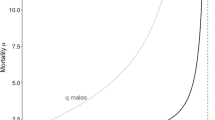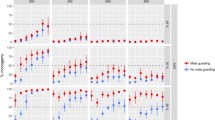Abstract
Influential models of male reproductive strategies have often ignored the importance of mate guarding, focusing instead on trade-offs between fitness gained through care for dependants in a pair bond versus fitness from continued competition for additional mates. Here we follow suggestions that mate guarding is a distinct alternative strategy that plays a crucial role, with special relevance to the evolution of our own lineage. Human pair bonding may have evolved in concert with the evolution of our grandmothering life history, which entails a shift to male-biased sex ratios in the fertile ages. As that sex ratio becomes more male biased, payoffs for mate-guarding increase due to partner scarcity. We present an ordinary differential equation model of mutually exclusive strategies (dependant care, multiple mating, and mate guarding), calculate steady-state frequencies and perform bifurcation analysis on parameters of care and guarding efficiency. Mate guarding triumphs over alternate strategies when populations are male biased, and guarding is fully efficient. When guarding does not ensure complete certainty of paternity, and multiple maters are able to gain some paternity from guarders, multiple mating can coexist with guarding. At female-biased sex ratios, multiple mating takes over, unless the benefit of care to the number of surviving offspring produced by the mates of carers is large.



Similar content being viewed by others
References
Alberts SC, Altmann J, Brockman DK, Cords M, Fedigan LM, Pusey A, Stoinski TS, Strier KB, Morris WF, Bronikowski AM (2013) Reproductive aging patterns in primates reveal that humans are distinct. Proc Natl Acad Sci 110(33):13440–13445
Blurton Jones N (2016) Demography and evolutionary ecology of Hadza hunter-gatherers, vol 71. Cambridge University Press, Cambridge
Blurton Jones NG, Marlowe FW, Hawkes K, O’Connell JF (2000) Paternal investment and hunter-gatherer divorce rates. In: Cronk L, Chagnon N, Irons W (eds) Adaptation and human behavior: an anthropological perspective. Aldine de Gruyter, New York, pp 69–90
Chapais B (2009) Primeval kinship: how pair-bonding gave birth to human society. Harvard University Press, Cambridge
Clutton-Brock TH, Parker GA (1992) Potential reproductive rates and the operation of sexual selection. Q Rev Biol 67:437–456
Coxworth JE, Kim PS, McQueen JS, Hawkes K (2015) Grandmothering life histories and human pair bonding. Proc Natl Acad Sci 112(38):11806–11811
Croft DP, Brent LJ, Franks DW, Cant MA (2015) The evolution of prolonged life after reproduction. Trends Ecol Evol 30(7):407–416
Fisher RA (1930) The genetical theory of natural selection: a complete, variorum edn. Oxford University Press, Oxford
Fromhage L, Elgar MA, Schneider JM (2005) Faithful without care: the evolution of monogyny. Evolution 59(7):1400–1405
Fromhage L, McNamara JM, Houston AI (2007) Stability and value of male care for offspring: is it worth only half the trouble? Biol Lett 3(3):234–236
Gavrilets S (2012) Human origins and the transition from promiscuity to pair-bonding. Proc Natl Acad Sci 109(25):9923–9928
Grafen A, Ridley M (1983) A model of mate guarding. J Theor Biol 102(4):549–567
Gross MR (2005) The evolution of parental care. Q Rev Biol 80(1):37–45
Harts AM, Kokko H (2013) Understanding promiscuity: when is seeking additional mates better than guarding an already found one? Evolution 67(10):2838–2848
Hawkes K, Rogers AR, Charnov EL (1995) The male’s dilemma: increased offspring production is more paternity to steal. Evol Ecol 9(6):662–677
Hawkes K, O’Connell JF, Jones NB, Alvarez H, Charnov EL (1998) Grandmothering, menopause, and the evolution of human life histories. Proc Natl Acad Sci 95(3):1336–1339
Hill K, Boesch C, Goodall J, Pusey A, Williams J, Wrangham R (2001) Mortality rates among wild chimpanzees. J Hum Evol 40(5):437–450
Hill K, Hurtado AM, Walker RS (2007) High adult mortality among hiwi hunter-gatherers: implications for human evolution. J Hum Evol 52(4):443–454
Hill KR, Hurtado AM (1996) Ache life history: the ecology and demography of a foraging people. Aldine de Gruyter, New York
Howell N (1979) Demography of the Dobe! kung. Academic Press, New York
Kim PS, Coxworth JE, Hawkes K (2012) Increased longevity evolves from grandmothering. Proc R Soc Lond B Biol Sci 279(1749):4880–4884
Kim PS, McQueen JS, Coxworth JE, Hawkes K (2014) Grandmothering drives the evolution of longevity in a probabilistic model. J Theor Biol 353:84–94
Kokko H (1999) Cuckoldry and the stability of biparental care. Ecol Lett 2(4):247–255
Kokko H, Jennions M (2003) It takes two to tango. Trends Ecol Evol 18(3):103–104
Kokko H, Jennions MD (2008) Parental investment, sexual selection and sex ratios. J Evol Biol 21(4):919–948
Kokko H, Rankin DJ (2006) Lonely hearts or sex in the city? density-dependent effects in mating systems. Philos Trans R Soc B Biol Sci 361(1466):319–334
Lancaster JB, Lancaster CS (1983) Parental investment: the hominid adaptation. In: Ortner DJ (ed) How humans adapt: a biocultural odyssey. Smithsonian Institution Press, Washington, pp 33–56
Lehtonen J, Parker GA, Schärer L (2016) Why anisogamy drives ancestral sex roles. Evolution 70(5):1129–1135
Levitis DA, Burger O, Lackey LB (2013) The human post-fertile lifespan in comparative evolutionary context. Evol Anthropol Issues News Rev 22(2):66–79
Lukas D, Clutton-Brock TH (2013) The evolution of social monogamy in mammals. Science 341(6145):526–530
Marlowe F (2000) Paternal investment and the human mating system. Behav Process 51(1):45–61
Marlowe FW, Berbesque JC (2012) The human operational sex ratio: effects of marriage, concealed ovulation, and menopause on mate competition. J Hum Evol 63(6):834–842
Muller MN, Wrangham RW (2014) Mortality rates among kanyawara chimpanzees. J Hum Evol 66:107–114
Parker GA, Stuart RA (1976) Animal behavior as a strategy optimizer: evolution of resource assessment strategies and optimal emigration thresholds. Am Nat 110:1055–1076
Schacht R, Bell AV (2016) The evolution of monogamy in response to partner scarcity. Sci Rep 6:32472. doi:10.1038/srep32472
Schacht R, Rauch KL, Mulder MB (2014) Too many men: the violence problem? Trends Ecol Evol 29(4):214–222
Trivers R (1972) Parental investment and sexual selection. In: Campbell B (ed) Sexual selection and the descent of man. Aldine de Gruyter, New York, pp 136–179
Tullock G (1974) The social dilemma: the economics of war and revolution. University Publications, Blacksburg
Washburn SL, Lancaster C (1968) The evolution of hunting. In: Lee RB, De Vore I (eds) Man the hunter. Aldine, Chicago, pp 293–303
Winkler DW (1987) A general model for parental care. Am Nat 130:526–543
Acknowledgements
SLL was supported by the Australian Postgraduate Award. MHC and PSK were supported by the Australian Research Council, Discovery Project (DP160101597).
Author information
Authors and Affiliations
Corresponding author
Appendix A
Appendix A
1.1 Female-Biased Steady-State Solutions
Example steady states given the parameter values in Table 3 can be calculated using the analytic expressions of the steady states presented in Sect. 3.1.1. The steady states, the corresponding eigenvalues, and the subsequent stability at each solution given these parameter values are:

1.2 Male-Biased Steady-State Solutions
Similarly, steady-state solutions for a male-biased sex ratio with other parameter values as summarised in Table 3 can be numerically determined. While analytic solutions for male-biased populations cannot be determined, we find that numerical simulations show the existence of one equilibrium point at a large P value of 0.74 and another stable state corresponding to extinction out of the paternal care strategy. Three numerical solutions of the three steady states are given below in Eq. 7. Numerical simulation of these solutions and bifurcations is conducted in AUTO07.

Rights and permissions
About this article
Cite this article
Loo, S.L., Chan, M.H., Hawkes, K. et al. Further Mathematical Modelling of Mating Sex Ratios & Male Strategies with Special Relevance to Human Life History. Bull Math Biol 79, 1907–1922 (2017). https://doi.org/10.1007/s11538-017-0313-2
Received:
Accepted:
Published:
Issue Date:
DOI: https://doi.org/10.1007/s11538-017-0313-2




